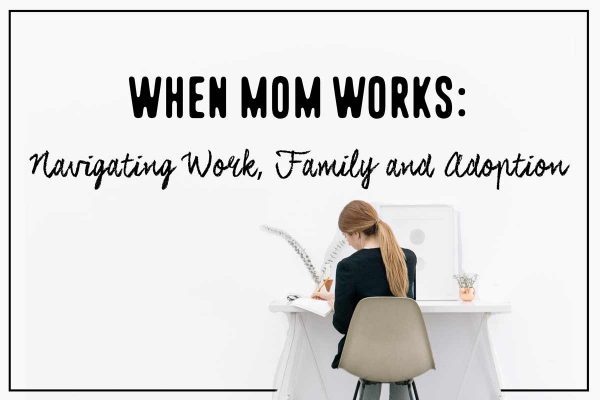
……………….
By the time we began the process to adopt from China, our hearts had been in it for several years. I spent those years reading every book, article and blog that I could find, in an effort to prepare myself for the realities of the journey we were about to begin.
As a family with two working parents, we expected our biggest hurdle — one that could potentially impact our ability to maintain both our careers — would be attachment issues. We knew that by adopting a child who had already lost so much, we would need to work extra hard to reinforce the meaning of family and the differences between mom/dad and various other caregivers. We spent hours discussing this with our social worker and sought childcare arrangements that we felt would be best for a child with potential attachment challenges.
And then, on a cloudy July afternoon in southern China, we met our precious daughter. We had known that she was very small and had some motor delays, which is not uncommon for children who have lived in an orphanage. Yet we were still caught off guard by how very small and how very delayed she was. At fifteen months old, she was not able to sit unassisted, much less crawl or walk. She weighed as much as an average three month old, and over the next few days, we realized that she also had difficulties with eating and drinking.
Right away, we knew that she would need much more than we anticipated in terms of medical support and therapies, and we were determined to get her all the help she needed. As it turns out, she has never shown any significant attachment difficulties, and that would be the least of our worries when returning to work.
Within weeks of coming home, the appointments began. It seemed that we left every appointment with referrals for multiple other appointments. International Adoption Clinic, ENT, Audiology, Ophthalmology, GI, Physical Therapy, Feeding Therapy, Occupational Therapy, Speech Therapy. For 12 weeks, I shuttled her to appointments almost every day, trying to check as many things off our to-do list as possible during my maternity leave.
In the final weeks leading up to my return to work, I began to panic. Not only would we need to juggle multiple therapy appointments each week, but her feeding challenges had reached an all-time high. We were barely treading water as it was, and somehow I was supposed to return to the office for 40 hours a week?
It seemed impossible.
But here we are, two years in, and not only is it possible — our daughter is thriving. It has taken flexibility and creativity, and sometimes life feels a little crazy, but truthfully it has been more doable than I ever expected.

First, we had to change our childcare plan. It quickly became clear that our daughter was not ready for the toddler preschool class in which we had secured a spot. With year-long waitlists at most centers and our daughter’s developmental delays, finding an appropriate daycare class for her was not going to be an option.
Just when things began to feel impossible, we stumbled upon the most perfect nanny scenario. I had been so concerned about attachment that I had not even considered a nanny — another woman, caring for and loving on my daughter all day? But thankfully, our daughter has had no difficulty distinguishing between her mama and her nanny, and it was exactly the environment that she needed. Our sweet nanny was able to meet her right where she was, developmentally, and there was no pressure to conform to “age appropriate” standards like sitting at a table for lunch or napping on a cot (things she would have been expected to do at preschool).
Next, we had to find a therapy schedule that worked for us. After weighing our options, I approached my boss about reducing my work schedule until we had a handle on our daughter’s needs. To be honest, I dreaded this conversation. I had only been at my company for a year, and while my large, international company offers flexible work arrangements, I worried that I was asking for too much, too soon. To my surprise and relief, my request was approved without issue, allowing me to work 30 hours per week (for 75% of my former salary). This way, I had a day off each week to take my daughter to her appointments, and I tried to schedule as much as possible for this day.
While back-to-back therapy appointments might be too much for some children, my daughter usually handles it well, and this was more convenient for us than running all over town multiple days each week. I also tried to consolidate as many therapies as possible at the same clinic, so that we could go straight from OT at 9:00 to PT at 10:00.
In addition to private therapy appointments, we also took advantage of the Early Intervention services offered by our county for children ages 0-2. Did you know that children who are eligible for Early Intervention can usually be seen by therapists at home or daycare? This allowed our daughter to receive therapy while she was home with our nanny. This can be a great benefit to working parents, but be aware that getting “into the system” can be notoriously slow, so you shouldn’t delay in requesting an Early Intervention evaluation.

One thing I have learned over the past two years is that a therapy schedule is not set in stone. Our plan has evolved as we try to find the therapies and therapists that are most effective for our daughter, while also aiming for the most convenient times and locations. We’ve learned to focus on what seems to be working at the time, and we aren’t afraid to take breaks or switch things up when needed.
Our time is too precious to spend an hour every week at a therapy that isn’t a great fit or that feels like a fight each time. In the beginning, I felt strongly about attending therapy appointments with my daughter. Not only did I want to learn how to continue therapy at home, but I was also concerned that sending her off by herself to various therapists could negatively impact her attachment to us. Over time, however, we have both become comfortable with her therapists and I have shifted some of her appointments so that our nanny takes her while I am at work. This has been immensely helpful in terms of scheduling.
Now that my daughter is three, she is eligible for services through our public school system under an IEP. At first, we were extremely hesitant to send our tiny toddler off to “big kid” school, but after a failed attempt at sending her to a “typical” church preschool, she now attends special needs Pre-K at our public elementary school three days a week, where she receives PT, OT and Speech throughout the day.
She is surrounded by a teacher, paraprofessionals and therapists who have the training and experience to help her meet her goals, and more importantly, who believe in her and appreciate her for who she is, regardless of her differences. And as working parents, the convenience of childcare and therapy rolled into one cannot be beat.
Sometimes it feels like we go to great lengths and make sacrifices, both personally and professionally, to make it all work, but continuing to invest in my career during this season of life has truly been the best thing for our family. I worked very hard for years to be where I am in my career, and I am proud of the work I do.
Being a mother brings me tremendous joy and purpose, but my career also brings fulfillment and intellectual stimulation that ultimately makes me a happier person and a better mom.
There are also tangible benefits to being a dual-working-parent family: My daughter is covered by both my and my husband’s insurance policies, enabling us to maximize coverage for her therapies and other medical resources. My salary affords us the luxury of pursuing new therapies and assistive devices without feeling burdened by the costs.
And perhaps the most unexpected benefit is that our daughter has an entire team of caregivers, teachers and therapists who love her and who cheer her on every week, in addition to mom and dad.
Sure, not everyone is able to cut back on their hours at work or hire a nanny. I know we are especially fortunate to be able to do these things, and I don’t want to discourage anyone whose circumstances are different than ours.
What I want you to know is that it is possible, but might require some outside-the-box thinking and trial and error.

If you had told me three years ago that we would be successfully juggling 4-5 therapy appointments each week, I wouldn’t have believed you for a second. But God has a way of working things out, and while I wish things came as easily for our daughter as they do for most other kids, I wouldn’t trade our life for anything.
Our daughter is 100% ours, regardless of how she came to us, and I am so thankful we can provide these resources for her and celebrate her successes together.
– guest post by Lindsey

























Leave a Reply